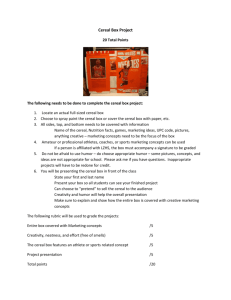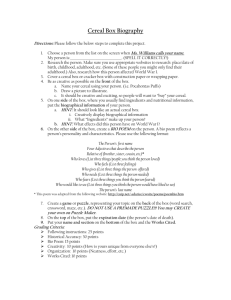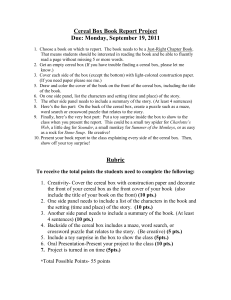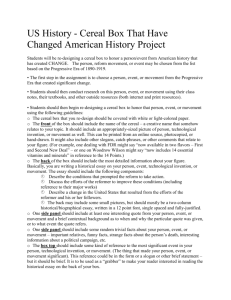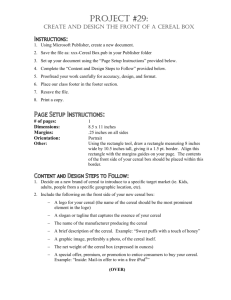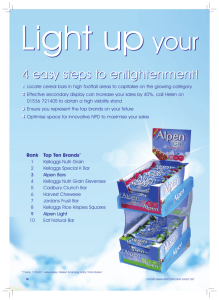Cereal Box Design Folder
advertisement
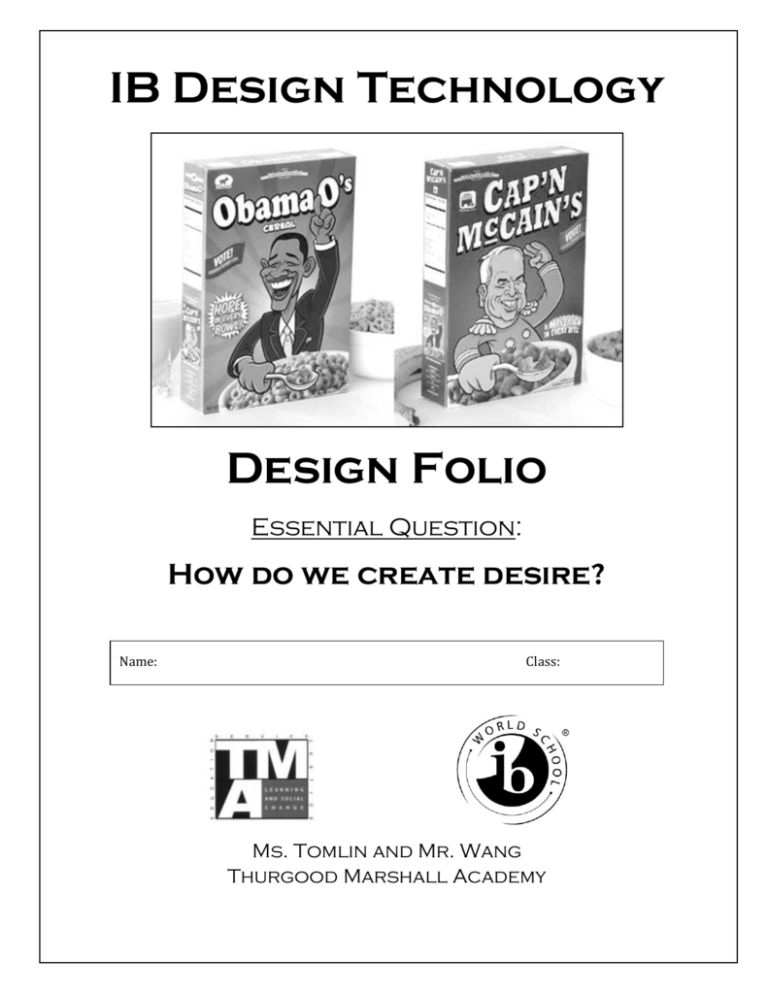
IB Design Technology Design Folio Essential Question: How do we create desire? Name: Class: Ms. Tomlin and Mr. Wang Thurgood Marshall Academy Table of Contents Essential Question .................................................... 3 The Task .................................................................... 3 Areas of Interaction (AoI) ......................................... 3 Objectives ................................................................. 3 Assessment ............................................................... 3 Guiding Question ...................................................... 4 The Design Brief ........................................................ 5 Product Analysis ....................................................... 6 Research ................................................................. 10 Specification ........................................................... 11 Initial Designs .......................................................... 12 Final Design ............................................................. 15 Adobe Lessons - Classwork ..................................... 15 Final Product Evaluation ......................................... 16 Final Product ........................................................... 19 IB Learner Profile .................................................... 20 Criterion A – Investigate ......................................... 21 Criterion B – Design ................................................ 22 Criterion C – Plan .................................................... 23 Criterion D – Create ................................................ 24 Criterion E – Evaluate ............................................. 25 Criterion F – Attitudes in Technology ..................... 26 Scoring Overview .................................................... 27 Cereal Box. IB Design Technology. Ms. Tomlin & Mr. Wang Page 2 Essential Question How do we create desire? The Task Working individually, students will be designing a cereal box to honor a person from World History. The person MAY NOT be American or Canadian and must have made a significant contribution (positive or negative) and a lasting contribution to World History. # _____________. Notable person: _________________________________________________________ Refer to http://tmatech.blogspot.com/ for the Notable People used in this project. Areas of Interaction (AoI) Human Ingenuity Desktop publishing, Marketing & Advertising Objectives Use of the design cycle Undertake meaningful and relevant research Gain experience utilizing Adobe applications Create, incorporate and manipulate digital images Manage time & resources Critically evaluate own work Assessment Create a Design Folio following the Design Cycle Maintain a design blog Provide several possible solutions and justify final choice Create solution to appropriate standard Test and evaluate solution Justify any changes Cereal Box. IB Design Technology. Ms. Tomlin & Mr. Wang Page 3 INVESTIGATE Guiding Question Explain in your own words the design task that you have been asked to solve. See Blog Entry # 3.2 – Design Task PLAN Timeline Date What was accomplished this session, tools used, problems encountered and how they were overcome. Cereal Box. IB Design Technology. Ms. Tomlin & Mr. Wang Time Spent Page 4 INVESTIGATE The Design Brief The design brief is the formal starting point of the design, states the expectations and design problem. It does not provide the solution. Here is an example: I am going to design and make a security device that will make my house look occupied when, in fact, it is empty. Police statistics clearly show that houses are much more likely to be broken into when they are empty. Consequently, if the house looks occupied it is likely to be safe. The device will be mobile so that it can be moved from room to room, easy to set up and control and also cheap to make. It must not be powered by main voltage and in this way it will be completely safe to be left ‘on’ for a long time and will not be affected by power cuts. It will be activated by anyone approaching the house from the front or back. It must deter even professional crooks from taking an interest in our house and even convince people in the street that the house is occupied. It should include the following elements: 1. Always start the design brief with “I am going to design and make .....”. This is followed by a general description of the type of device you feel will answer the design problem. 2. Do not be too specific. The brief should be a general description that allows you flexibility regarding the type of product you intend to make. For example, if you are designing an automatic animal feeder it may be a good idea not to say the type of animal it is for, at least not at this stage in the project. 3. Do not be specific about materials. It may be wise to avoid stating the exact materials it will be manufactured from (eg. pine, steel, etc...). Instead describe the materials to be used as strong, tough, flexible, natural, man-made, recycled, water-proof or similar general descriptions. 4. Mention points such as – general size, what it will do (it’s functions), general properties of the materials needed, who it is for (e.g. children), and other points you feel are important. Write a Design Brief for your project. See Blog Entry # 3.3 – Design Brief Cereal Box. IB Design Technology. Ms. Tomlin & Mr. Wang Page 5 INVESTIGATE Product Analysis Looking at similar products is a useful form of research. You can learn quickly about the different methods and techniques used to solve a problem similar to your own. This leaves you in a good starting point to think about your own solution. Examine the cereal box below, and annotate thoroughly by answering the following questions. What does this text represent? What does this text represent? What does this text represent? What two images appear on the box? Why are these images used? Cereal Box. IB Design Technology. Ms. Tomlin & Mr. Wang Page 6 INVESTIGATE Get a family-sized cereal box. Measure the dimensions of your box. Use the diagram at the left as a guide. Length: _____________inches Height: _____________inches Height Width: _____________inches Width Length Front of Box Compare the front of your cereal box with the Lucky Charms from page 6. How is the layout (arrangement of the text and images) similar? How is the layout (arrangement of the text and images) different? Cereal Box. IB Design Technology. Ms. Tomlin & Mr. Wang Page 7 INVESTIGATE Back of Box In the same way we annotated the front of the box on page 6, annotate the back of your cereal box. Include a labeled sketch of the back of your cereal box. Cereal Box. IB Design Technology. Ms. Tomlin & Mr. Wang Page 8 Panels of Box Annotate the panels of your cereal box. Include a labeled sketch. Left Panel Right Panel Top Panel Bottom Panel Cereal Box. IB Design Technology. Ms. Tomlin & Mr. Wang Page 9 INVESTIGATE Research Blog Entry # 3.1 – Person Research Use credible on-line sources to research your assigned person. Answer the following as: 1. Name of Notable Person 2. Web Addresses of all Sources (copy and paste) 3. Biographical Information a. b. c. d. e. Date of Birth and Death Place of Birth and Death (or current residence) Family (e.g. parents, siblings, spouse, children) Education Occupation 4. Two-three Quotes (either about the person of from the person) 5. Significant contribution(s) to World History 6. Two-three pictures of the person (should be of a large size) 7. Ten terms related to the person 8. Timeline of at least five important dates in the person’s life 9. A symbol that represents the person (include a description of why it symbolizes the person) Cereal Box. IB Design Technology. Ms. Tomlin & Mr. Wang Page 10 INVESTIGATE Specification A Specification is a list of key points that your design must take into account. The specification is written after the design brief has been analyzed and research has been carried out. What design considerations must you include in this particular project? Required Design Elements: Your cereal box will be designed according to the following guidelines: The cereal box that you are using must be covered so that no original markings, drawings or writing is showing The front of the cereal box should include the name of the cereal – a creative name that somehow relates to your hero. It should include an appropriately-sized picture of your hero as well (if an actual photo of your person is not available any image can be used i.e. a portrait, cartoon, statue, etc.). The front should also include a slogan for the cereal that relates to your individual. Your name should be incorporated as the name of the cereal company. The back of the box should include the most detailed information on your figure. o Information (creatively displayed) on the birth, education and early years of your person o Information on any controversies (any serious flaws) that your person was involved in o A summation of the characteristics that makes this person an important person in Global History o A game/puzzle (crossword, word find, etc.) based on information about your person o Some small pictures One side panel should include at least one interesting quote from your hero (or about your hero) and a brief contextual background as to when and why that particular quote was given, or to what event the quote refers and some random trivial facts about your person One side panel should include a timeline about your person The top panel should include some reference to the most significant event in your person’s life. This reference could be in the form of a slogan or other brief statement – but it should be brief. It is to be used as a grabber to make your reader interested in reading the historical information on the back of your essay. The bottom panel should include a bibliography in MLA format. While you are completing your research collect information on the sources that you are using to gather information on your person. Time to Complete Project: Cereal Box. IB Design Technology. Ms. Tomlin & Mr. Wang Page 11 DESIGN Initial Designs Create sketches of your cereal box (front and back) indicating possible layouts, heading types, colors etc. Annotate each design thoroughly. Front Cereal Box. IB Design Technology. Ms. Tomlin & Mr. Wang Page 12 DESIGN Back Cereal Box. IB Design Technology. Ms. Tomlin & Mr. Wang Page 13 DESIGN Top Left Panel Cereal Box. IB Design Technology. Ms. Tomlin & Mr. Wang Right Panel Page 14 DESIGN Final Design Justify your choice of final design and explain how you have met the Design Specification. What font will you use and why? Why is this design better than the others? Explain your layout choices. How will you create these panels of your cereal box? Blog Entry # 3.6 – Final Design CREATE Adobe Lessons - Classwork Blog Entry # 3.4 – Adobe I Classwork for Week 2 Blog Entry # 3.5 – Adobe II Classwork for Week 3 Cereal Box. IB Design Technology. Ms. Tomlin & Mr. Wang Page 15 EVALUATION Final Product Evaluation Evaluation is perhaps the most important part of the Design Cycle. You need to evaluate the final product, evaluate each stage of the Design Cycle and evaluate against the Areas of Interaction. Evaluation of: FINAL PRODUCT How could you improve your design? Cereal Box. IB Design Technology. Ms. Tomlin & Mr. Wang Page 16 Evaluation of Design Cycle: INVESTIGATION Evaluation of Design Cycle: DESIGN & PLAN Describe how your cereal box research affected the final design of your product. Which panel of the final product least resembled the initial sketch? What changes were made and why? Cereal Box. IB Design Technology. Ms. Tomlin & Mr. Wang Page 17 EVALUATION Evaluation of What problems did you have? How did you solve them? Design Cycle: What new technology skills did you learn during this project? How will you use these skills in other classes? CREATE Evaluation of Design Cycle: Which Learner Profile quality was your greatest strength during this project? Explain. ATTITUDES IN TECHNOLOGY Which Learner Profile quality was your greatest challenge during this project? Explain. Did you work to the best of your ability? Explain. Cereal Box. IB Design Technology. Ms. Tomlin & Mr. Wang Page 18 EVALUATION Evaluation of Areas of Interaction: Human Ingenuity Who might boycott your cereal box? Why? Who might buy every box of your cereal? Why? Final Product Include the completed cereal box with your Design Folio. Cereal Box. IB Design Technology. Ms. Tomlin & Mr. Wang Page 19 IB Learner Profile The aim of all IB programmes is to develop internationally minded people who, recognizing their common humanity and shared guardianship of the planet, help to create a better and more peaceful world. IB learners strive to be: Inquirers They develop their natural curiosity. They acquire the skills necessary to conduct inquiry and research and show independence in learning. They actively enjoy learning and this love of learning will be sustained throughout their lives. Knowledgeable They explore concepts, ideas and issues that have local and global significance. In so doing, they acquire in-depth knowledge and develop understanding across a broad and balanced range of disciplines. Thinkers They exercise initiative in applying thinking skills critically and creatively to recognize and approach complex problems, and make reasoned, ethical decisions. Communicators They understand and express ideas and information confidently and creatively in more than one language and in a variety of modes of communication. They work effectively and willingly in collaboration with others. Principled They act with integrity and honesty, with a strong sense of fairness, justice and respect for the dignity of the individual, groups and communities. They take responsibility for their own actions and the consequences that accompany them. Open-minded They understand and appreciate their own cultures and personal histories, and are open to the perspectives, values and traditions of other individuals and communities. They are accustomed to seeking and evaluating a range of point of view, and are willing to grow from the experience. Caring They show empathy, compassion and respect towards the needs and feelings of others. They have a personal commitment to service, and act to make a positive difference to the lives of others and to the environment. Risk-takers They approach unfamiliar situations and uncertainty with courage and forethought, and have the independence of spirit to explore new roles, ideas and strategies. They are brave and articulate in defending their beliefs. Balanced They understand the importance of intellectual, physical and emotional balance to achieve personal well-being for themselves and others. Reflective They give thoughtful consideration to their own learning and experience. They are able to assess and understand their strengths and limitations in order to support their learning and personal development. Cereal Box. IB Design Technology. Ms. Tomlin & Mr. Wang Page 20 RUBRICS Criterion A – Investigate Maximum: 6 Investigation is an essential stage in the design cycle. Students are expected to identify the problem, develop a design brief and formulate a design specification. Students are expected to acknowledge the sources of information and document these appropriately. Achievement Level 0 1–2 3–4 5–6 Level Descriptor The student does not reach a standard described by any of the descriptors given below. The student states the problem. The student investigates the problem, collecting information from sources. The student lists some specifications. The student describes the problem, mentioning its relevance. The student investigates the problem, selecting and analysing information from some acknowledged sources. The student describes a test to evaluate the product/solution against the design specification. The student explains the problem, discussing its relevance. The student critically investigates the problem, evaluating information from a broad range of appropriate, acknowledged sources. The student describes detailed methods for appropriate testing to evaluate the product/solution against the design specification. Scoring Criteria A: Cereal Box. IB Design Technology. Ms. Tomlin & Mr. Wang out of 6 Page 21 RUBRICS Criterion B – Design Maximum: 6 Students are expected to generate several feasible designs that meet the design specification and to evaluate these against the design specification. Students are then expected to select one design, justify their choice and evaluate this in detail against the design specification. Achievement Level 0 1–2 3–4 5–6 Level Descriptor The student does not reach a standard described by any of the descriptors given below. The student generates one design, and makes some attempt to justify this against the design specification. The student generates a few designs, justifying the choice of one design and fully evaluating this against the design specification. The student generates a range of feasible designs, each evaluated against the design specification. The student justifies the chosen design and evaluates it fully and critically against the design specification. Scoring Criteria B: Cereal Box. IB Design Technology. Ms. Tomlin & Mr. Wang out of 6 Page 22 RUBRICS Criterion C – Plan Maximum: 6 Students are expected to construct a plan to create their chosen product/solution that has a series of logical steps, and that makes effective use of resources and time. Students are expected to evaluate the plan and justify any modifications to the design. Achievement Level Level Descriptor 0 The student does not reach a standard described by any of the descriptors given below. 1–2 The student produces a plan that contains some details of the steps and/or the resources required. 3–4 The student produces a plan that contains a number of logical steps that include resources and time. The student makes some attempt to evaluate the plan. 5–6 The student produces a plan that contains a number of detailed, logical steps that describe the use of resources and time. The student critically evaluates the plan and justifies any modifications to the design. Scoring Criteria C: Cereal Box. IB Design Technology. Ms. Tomlin & Mr. Wang out of 6 Page 23 RUBRICS Criterion D – Create Maximum: 6 Students are expected to document, with a series of photographs or a video and a dated record, the process of making their product/solution, including when and how they use tools, materials and techniques. Students are expected to follow their plan, to evaluate the plan and to justify any changes they make to the plan while they are creating the product/solution. Students will sometimes embark upon a very ambitious project, or they may encounter unforeseen circumstances. In some circumstances a product/solution that is incomplete or does not function fully can still achieve one of the levels awarded for this criterion. Achievement Level 0 Level Descriptor The student does not reach a standard described by any of the descriptors given below. 1–2 The student considers the plan and creates at least part of a product/solution. 3–4 The student uses appropriate techniques and equipment. The student follows the plan and mentions any modifications made, resulting in a product/solution of good quality. 5–6 The student competently uses appropriate techniques and equipment. The student follows the plan and justifies any modifications made, resulting in a product/solution of appropriate quality using the resources available. Scoring Criteria D: Cereal Box. IB Design Technology. Ms. Tomlin & Mr. Wang out of 6 Page 24 RUBRICS Criterion E – Evaluate Maximum: 6 Students are expected to evaluate the product/solution against the design specification in an objective manner based on testing, and to evaluate its impact on life, society and/or the environment. They are expected to explain how the product/solution could be improved as a result of these evaluations. Students are expected to evaluate their own performance at each stage of the design cycle and to suggest ways in which their performance could be improved. Achievement Level Level Descriptor 0 The student does not reach a standard described by any of the descriptors given below. 1–2 The student evaluates the product/solution or his or her own performance. The student makes some attempt to test the product/solution. 3–4 5–6 The student evaluates the product/solution and his or her own performance and suggests ways in which these could be improved. The student tests the product/solution to evaluate it against the design specification. The student evaluates the success of the product/solution in an objective manner based on the results of testing, and the views of the intended users. The student provides an evaluation of his or her own performance at each stage of the design cycle and suggests improvements. The student provides an appropriate evaluation of the impact of the product/solution on life, society and/or the environment. Scoring Criteria E: Cereal Box. IB Design Technology. Ms. Tomlin & Mr. Wang out of 6 Page 25 RUBRICS Criterion F – Attitudes in Technology Maximum: 6 This criterion refers to students’ attitudes when working in technology. It focuses on an overall assessment of two aspects: personal engagement (motivation, independence, general positive attitude) attitudes towards safety, cooperation and respect for others. By their very nature these qualities are difficult to quantify and assess, and assessment should therefore take into account the context in which the unit of work was undertaken. Achievement Level 0 1–2 3–4 5–6 Level Descriptor The student does not reach a standard described by any of the descriptors given below. The student occasionally displays a satisfactory standard in one of the aspects listed above. The student frequently displays a satisfactory standard in both of the aspects listed above. The student consistently displays a satisfactory standard in both of the aspects listed above. Scoring Criteria F: Cereal Box. IB Design Technology. Ms. Tomlin & Mr. Wang out of 6 Page 26 Scoring Overview Criterion A Investigate out of 6 Criterion B Design out of 6 Criterion C Plan out of 6 Criterion D Create out of 6 Criterion E Evaluate out of 6 Criterion F Attitudes in Technology out of 6 Point Total (out of 36) Overall Grade Points 1 0-5 2 6-9 3 10-15 4 16-21 5 22-26 6 27-31 7 32-36 Cereal Box. IB Design Technology. Ms. Tomlin & Mr. Wang Page 27


